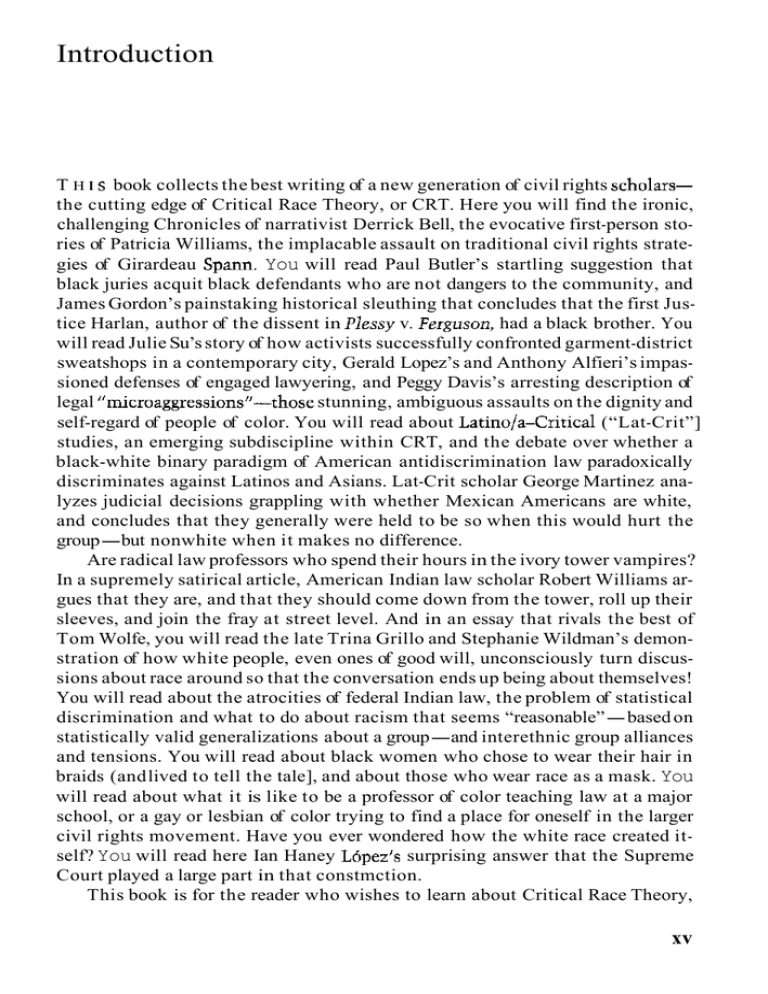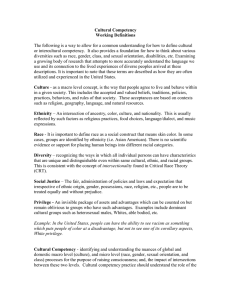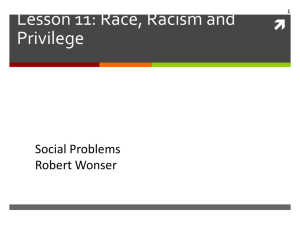Introduction
advertisement

Introduction T H I s book collects the best writing of a new generation of civil rights scholarsthe cutting edge of Critical Race Theory, or CRT. Here you will find the ironic, challenging Chronicles of narrativist Derrick Bell, the evocative first-person stories of Patricia Williams, the implacable assault on traditional civil rights strategies of Girardeau Spann. You will read Paul Butler’s startling suggestion that black juries acquit black defendants who are not dangers to the community, and James Gordon’s painstaking historical sleuthing that concludes that the first Justice Harlan, author of the dissent in Plessy v. Ferguson, had a black brother. You will read Julie Su’s story of how activists successfully confronted garment-district sweatshops in a contemporary city, Gerald Lopez’s and Anthony Alfieri’s impassioned defenses of engaged lawyering, and Peggy Davis’s arresting description of legal “microaggressions”-those stunning, ambiguous assaults on the dignity and self-regard of people of color. You will read about Latino/a-Critical (“Lat-Crit”] studies, an emerging subdiscipline within CRT, and the debate over whether a black-white binary paradigm of American antidiscrimination law paradoxically discriminates against Latinos and Asians. Lat-Crit scholar George Martinez analyzes judicial decisions grappling with whether Mexican Americans are white, and concludes that they generally were held to be so when this would hurt the group-but nonwhite when it makes no difference. Are radical law professors who spend their hours in the ivory tower vampires? In a supremely satirical article, American Indian law scholar Robert Williams argues that they are, and that they should come down from the tower, roll up their sleeves, and join the fray at street level. And in an essay that rivals the best of Tom Wolfe, you will read the late Trina Grillo and Stephanie Wildman’s demonstration of how white people, even ones of good will, unconsciously turn discussions about race around so that the conversation ends up being about themselves! You will read about the atrocities of federal Indian law, the problem of statistical discrimination and what to do about racism that seems “reasonable”-based on statistically valid generalizations about a group-and interethnic group alliances and tensions. You will read about black women who chose to wear their hair in braids (and lived to tell the tale], and about those who wear race as a mask. You will read about what it is like to be a professor of color teaching law at a major school, or a gay or lesbian of color trying to find a place for oneself in the larger civil rights movement. Have you ever wondered how the white race created itself? You will read here Ian Haney L6pez’s surprising answer that the Supreme Court played a large part in that constmction. This book is for the reader who wishes to learn about Critical Race Theory, xv xvi Introduction a dynamic, eclectic, and growing movement in the law, and about the young writers, many but by no means all of color, who have been challenging racial orthodoxy, shaking up the legal academy, questioning comfortable liberal premises, and leading the search for new ways of thinking about our nation’s most intractable, and insoluble, problem-race. Critical Race Theory sprang up in the mid-1970s with the early work of Derrick Bell [an African American) and Alan Freeman [a white), both of whom were deeply distressed over the slow pace of racial reform in the United States. It seemed to them-and they were quickly joined by others-that the civil rights movement of the 1960s had stalled, and indeed that many of its gains were being rolled back. New approaches were needed to understand and come to grips with the more subtle, but just as deeply entrenched, varieties of racism that characterize our times. Old approaches-filing amicus briefs, marching, coining new litigation strategies, writing articles in legal and popular journals exhorting our fellow citizens to exercise moral leadership in the search for racial justice-were yielding smaller and smaller returns. As Freeman once put it, if you are up a tree and a flood is coming, sometimes you have to climb down before finding shelter in a taller, safer one. Out of this need came Critical Race Theory, now a body of more than four hundred leading law review articles and dozens of books, most of which are noted or excerpted in this volume. The movement has predecessors-Critical Legal Studies, to which it owes a great debt, feminism, and continental social and political philosophy. It derives its inspiration from the American civil rights tradition, as represented by such leaders as Martin Luther King, W.E.B. Du Bois, Rosa Parks, and Cksar Chavez, and from nationalist movements, as manifested by such figures as Malcolm X and the Black Panthers. Although its intellectual origins go back much further, as a self-conscious entity the CRT movement began organizing in 1989, holding its first working session shortly thereafter. This book grew out of the 1993 annual summer workshop held at Mills College in Oakland, California, when the organization decided to put its energies into producing a reader. The first edition, which appeared in 1995, was adopted in courses in more than one hundred colleges and universities around the world. This second edition builds on the first but contains much new material, including major sections dealing with crime, gay-lesbian issues, the black-white binary, intergroup tensions, and critical race practice and activism. It also includes much new writing by young Asian and Latino/a scholars. CRT begins with a number of basic insights. One is that racism is normal, not aberrant, in American society. Because racism is an ingrained feature of our landscape, it looks ordinary and natural to persons in the culture. Formal equal opportunity-rules and laws that insist on treating blacks and whites [for example! alike-can thus remedy only the more extreme and shocking forms of injustice, the ones that do stand out. It can do little about the business-as-usual forms of racism that people of color confront every day and that account for much misery, alienation, and despair. Introduction xvii Critical Race Theory’s challenge to racial oppression and the status quo sometimes takes the form of storytelling in which writers analyze the myths, presuppositions, and received wisdoms that make up the common culture about race and that invariably render blacks and other minorities one-down. Starting from the premise that a culture constmcts its own social reality in ways that promote its own self-interest, these scholars set out to construct a different reality. Our social world, with its rules, practices, and assignments of prestige and power, is not fixed; rather, we construct it with words, stories, and silence. But we need not acquiesce in arrangements that are unfair and one-sided. By writing and speaking against them, we may hope to contribute to a better, fairer world. A third premise underlying much of Critical Race Theory is interest convergence. Developed by Derrick Bell, this concept holds that white elites will tolerate or encourage racial advances for blacks only when such advances also promote white self-interest. Other Criticalists question whether civil rights law is designed to benefit folks of color, and even suggest that it is really a homeostatic mechanism that ensures that racial progress occurs at just the right pace: Change that is too rapid would be unsettling to society at large; that which is too slow could prove destabilizing. Many question whether white judges are likely to propel racial change, raising the possibility that nonjudicial avenues may prove more promising. A number of writers employ Critical tools to address such classic civil rights issues as federal Indian law, remedies for racist speech and hate-motivated crime, and women’s reproductive liberty. In addition to exploring new approaches to racial justice, Criticalists have been trying out new forms of writing and thought. Many Critical writers are postmoderns, who believe that form and substance are closely connected. Accordingly, they have been using biography and autobiography, stories and counterstories, to expose the false necessity and unintentional irony of much current civil rights law and scholarship. Others have been experimenting with humor, satire, and narrative analysis to reveal the circular, self-serving nature of particular legal doctrines or rules. Most mainstream scholars embrace universalism over particularity, and abstract principles and the “rule of law” over perspectivism (an approach characterized by an emphasis on how it was for a particular person at a particular time and place). Clashing with this more traditional view, Critical Race Theory writers emphasize the opposite, in what has been termed the “call to context.” For CRT scholars, general laws may be appropriate in some areas [such as, perhaps, trusts and estates, or highway speed limits], but political and moral discourse is not one of them. Normative discourse (which civil rights is) is highly fact-sensitive, which means that adding even one new fact can change intuition radically. For example, imagine a youth convicted of a serious crime. One’s first response may be to urge severe punishment. But add one fact-he was seen laughing as he walked away from the scene-and one’s intuition changes: Even more serious punishment now seems appropriate. But add another fact-he is mentally impaired or was abused as a child-and now leniency seems in order. Because civil rights is more like the latter case than the former (highway law), xviii Introduction neutral universal principles like formal equality can be more of a hindrance than a help in the search for racial justice. For this reason, many CRT writers urge attention to the details of minorities’ lives as a foundation for our national civil rights strategy. Each of the prime Critical themes just mentioned-the insistence that racism is ordinary and not exceptional, the notion that traditional civil rights law has been more valuable to whites than to blacks, the critique of liberalism, and the call to context-has come in for criticism. Some mainstream critics challenge the use of stories and parables, warning that they can be employed to mislead as easily as ordinary analysis can. Others charge that the “race-Crits” are too negative, and that the despairing images of racial progress and regress that they put forward leave too little room for hope. Still others write that we play fast and loose with truth, or “play the race card” in trials. A number of these arguments appear in this volume, particularly in Part XV, along with the Crits’ responses. Ultimately, the reader will have to decide whether our system of civil rights law needs a complete overhaul, as the CRT writers argue, or just a minor tune-up, and, if the former is true, whether the race-Crits’ suggestions are good places to start. It is with the hope that the sixty-three closely edited selections by the enfants terribles (and bminences grises) of the left can help the reader make this decision, that Temple University Press offers this book. A N o T E about the selections that make up this volume: We chose articles that are original, readable, and illustrative of a number of themes we deemed characteristic of Critical Race Theory. Space considerations prevented us from including many excellent works; these are generally mentioned in the Notes or Suggested Readings. Most of the articles that appear here have been edited for readability and the number of footnotes radically pruned. Readers desiring the complete works will find the citations at the bottom of each article-opening page. A few authors declined to participate. In particular, three articles that played important parts in the early development of Critical Race Theory could not be included. All of these influential articles are mentioned in the relevant Suggested Readings. Each spurred additional scholarly articles that extended and explored their ideas, many of which are included in this book. The three articles are significant for their role in the formation of Critical theory, however, and warrant separate treatment here. In 1987, a “summit meeting” of the Conference of Critical Legal Studies in Los Angeles was called in order to discuss, for the first time in an extended way, issues of relevance to the minority community. Several of the presentations were later printed in a special edition of Harvard Civil Rights-Civil Liberties L a w R e v i e w entitled ”Minority Critiques of the Critical Legal Studies Movement.” These articles included “Looking to the Bottom” by Professor Mari Matsuda of Georgetown Law Center (cited fully in the Suggested Readings for Part XV]. Matsuda praised the theories and critiques of writers in the CLS movement, but nevertheless urged that their work could be improved by the practice of looking to the stories and viewpoints of persons of color who have experienced racism. She theorized that this practice of “looking to the bottom” can Introduction xix enhance jurisprudential method and in particular that it justifies a reparationsoriented approach to racial justice. In an article published in the same year, Professor Charles Lawrence of Georgetown Law Center argued that much discrimination is unconscious, that is, devoid of any intent on the part of the actor to harm or disadvantage a particular black victim. Yet, legal doctrine for the most part requires demonstration of intent. In “The Id, the Ego, and Equal Protection” (cited fully i n the Suggested Readings for Part IV), Lawrence urged that the Supreme Court’s approach in Washington v. Davis (a major case on “intent versus effects”) is inadequate to deal with racism that is implicit, or latent, rather than express. He proposed a new “cultural meaning” test, according to which courts would look to cultural symbols to decide whether an act’s meaning is racially discriminatory. The article constituted an important early use of social science to expose the deficiencies of legal doctrine. Finally, in “Race, Reform, and Retrenchment” (cited fully in Suggested Readings for Part I), CRT co-founder Kimberl6 Crenshaw critiqued the conservative right’s and the liberal left’s approaches to antidiscrimination law. Echoing the work of others, she argued that “color-blind” race-reform law, espoused by the conservative right, can make only modest inroads into institutionalized racism. But she also pointed out that the left’s harsh criticism of such measures ignores the benefits they can provide, while downplaying the role of racism in legitimizing oppression. Her article constituted an early, and influential, attempt to delineate the differences between Critical and non-Critical approaches to racial justice. Suggested Readings Alfieri, Anthony V., Black and White, 85 CALIF. L. REV. 1647 (1997),10 LA RAZAL.J. 561 (1998). Brooks, Roy L., & Mary Jo Newborn, Critical Race Theory and Classical-Liberal Civil Rights Scho1arship:A Distinction Without a Difference!, 82 CALIF. L. REV. 787 (1994). Calmore, John O., Critical Race Theory, Archie Shepp, and Fire Music: Securing an A u thentic Intellectual Life in a Multicultural World, 65 S . CAL. L. REV. 2129 (1992). Colloquy, Responses to Randall Kennedy’s Racial Critiques o f Legal Academia, 103 HARV. L. REV. 1844 (1990). CRITICAL RACE THEORY: THE KEY WRITlNGS THAT FORMED THE MOVEMENT, Introduction at xiii (KimberleCrenshaw, Neil Gotanda, Gary Peller & Kendall Thomas eds. 1995). Delgado, Richard, Critical Race Theory, 19 SAGE RACEREL. ABSTRACTS NO. 2, at 3 (1994). Harris, Angela P., Foreword: The Iurisprudence of Reconstruction, 82 CALIF. L. REV. 741 (1994). Hayman, Robert L., Jr., The Color o f Tradition: Critical Race Theory and Postmodern Constitutional Traditionalism, 30 HARV. C.R.-C.L.L. REV. 57 (1995). Karst, Kenneth L., Integration Success Story, 69 S . CAL. L. REV. 1781 (1996). Symposium, Critical Race Theory, 82 CALIF. L. REV. 741 (1994).






